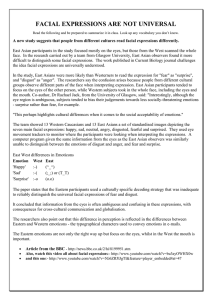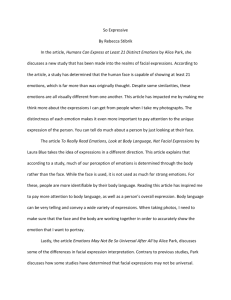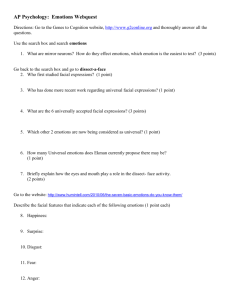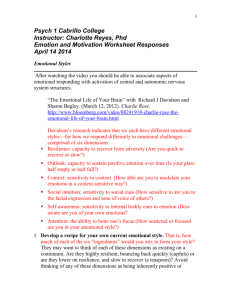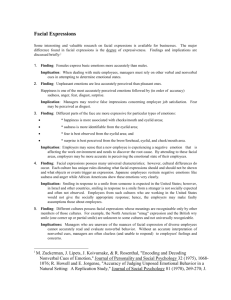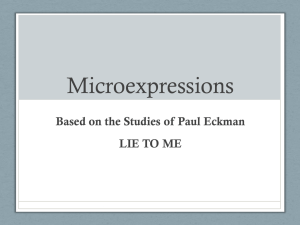Are Emotions Universal
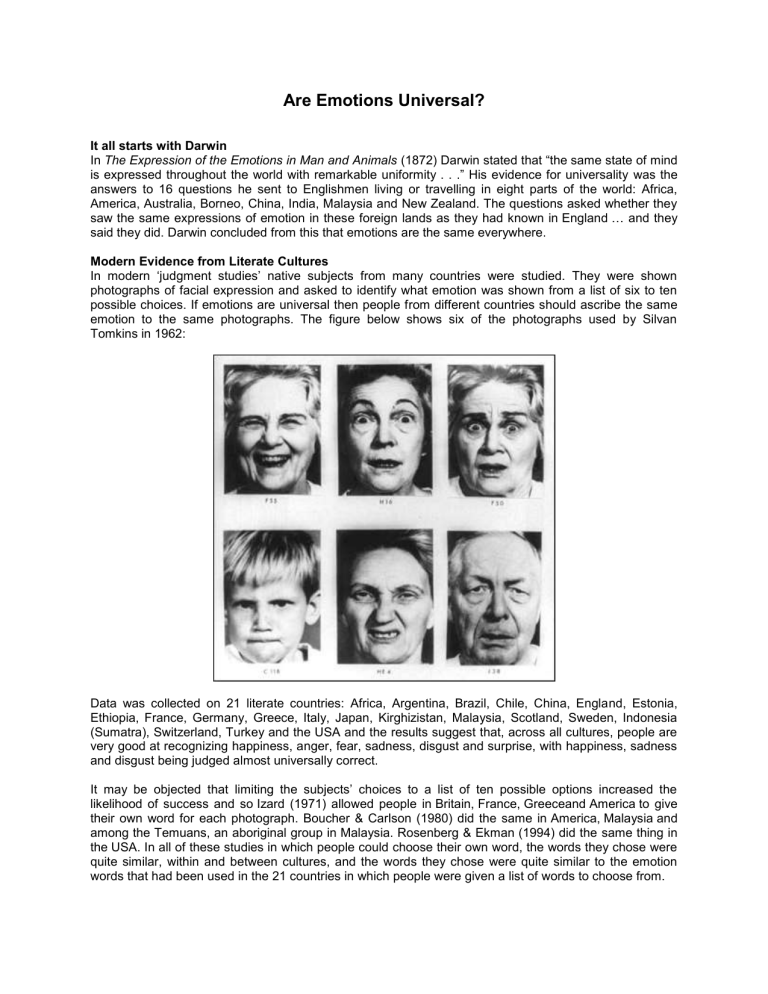
Are Emotions Universal?
It all starts with Darwin
In The Expression of the Emotions in Man and Animals (1872) Darwin stated that “the same state of mind is expressed throughout the world with remarkable uniformity . . .” His evidence for universality was the answers to 16 questions he sent to Englishmen living or travelling in eight parts of the world: Africa,
America, Australia, Borneo, China, India, Malaysia and New Zealand. The questions asked whether they saw the same expressions of emotion in these foreign lands as they had known in England … and they said they did. Darwin concluded from this that emotions are the same everywhere.
Modern Evidence from Literate Cultures
In modern ‘judgment studies’ native subjects from many countries were studied. They were shown photographs of facial expression and asked to identify what emotion was shown from a list of six to ten possible choices. If emotions are universal then people from different countries should ascribe the same emotion to the same photographs. The figure below shows six of the photographs used by Silvan
Tomkins in 1962:
Data was collected on 21 literate countries: Africa, Argentina, Brazil, Chile, China, England, Estonia,
Ethiopia, France, Germany, Greece, Italy, Japan, Kirghizistan, Malaysia, Scotland, Sweden, Indonesia
(Sumatra), Switzerland, Turkey and the USA and the results suggest that, across all cultures, people are very good at recognizing happiness, anger, fear, sadness, disgust and surprise, with happiness, sadness and disgust being judged almost universally correct.
It may be objected that limiting the subjects’ choices to a list of ten possible options increased the likelihood of success and so Izard (1971) allowed people in Britain, France, Greeceand America to give their own word for each photograph. Boucher & Carlson (1980) did the same in America, Malaysia and among the Temuans, an aboriginal group in Malaysia. Rosenberg & Ekman (1994) did the same thing in the USA. In all of these studies in which people could choose their own word, the words they chose were quite similar, within and between cultures, and the words they chose were quite similar to the emotion words that had been used in the 21 countries in which people were given a list of words to choose from.
Modern Evidence from Preliterate, Visually Isolated Cultures
But what if we had all just learnt to have the same facial expressions because of our shared culture? To answer this criticism the South Fore culture in Papua New Guinea were studied in 1967.These people were visually isolated: most had seen few or no outsiders. They were still using stone implements, and had never seen a photograph, magazine, film or television and so could not have learnt these faces from the media.
The procedure adopted had been used many years earlier for studying young children who also can not read. A translator read the person a brief story, and asked the person to point to the picture which fitted that story and, in general, they chose the same expressions for each emotion as had the people in the 21 literate cultures (Ekman & Friesen, 1971). The only exception was that they failed to distinguish the fear and surprise faces from each other, although both were distinguished from anger, happiness, sadness and disgust expressions.
In addition the people of the Fore were videotaped while showing what their face would look like in a given situation and the videotaped images were then shown to Americans who once again recognised all of the emotions except fear and surprise (Ekman, 1972). See below:
Further studies carried out in this field and challenges to the evidence are reported in Dalgleish, T., &
Power, M. (1999). Handbook of Cognition and Emotion. New York: John Wiley & Sons Ltd. Ch.16.
In Conclusion
It seems reasonable to propose that there are universal facial expressions (at least for the simple emotions of happiness, anger, disgust, sadness and fear/surprise) and that these common facial expressions are the result of a common set of basic emotions that all humans share. That does not mean that expressions will always occur when emotions are experienced, for we are capable of inhibiting our expressions. Nor does it mean that emotions will always have been the cause of a facial expression, for we are capable of fabricating an expression.
It may be argued that there is no proof of a connection between emotions and facial expressions.
However, while technically true this does run somewhat contrary to common sense and, more importantly, it also would make it very difficult to explain why, if we are all feeling different things, we tend to use the same facial expressions in the same situations.
